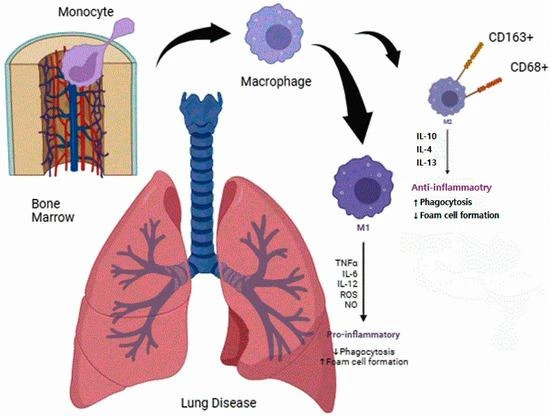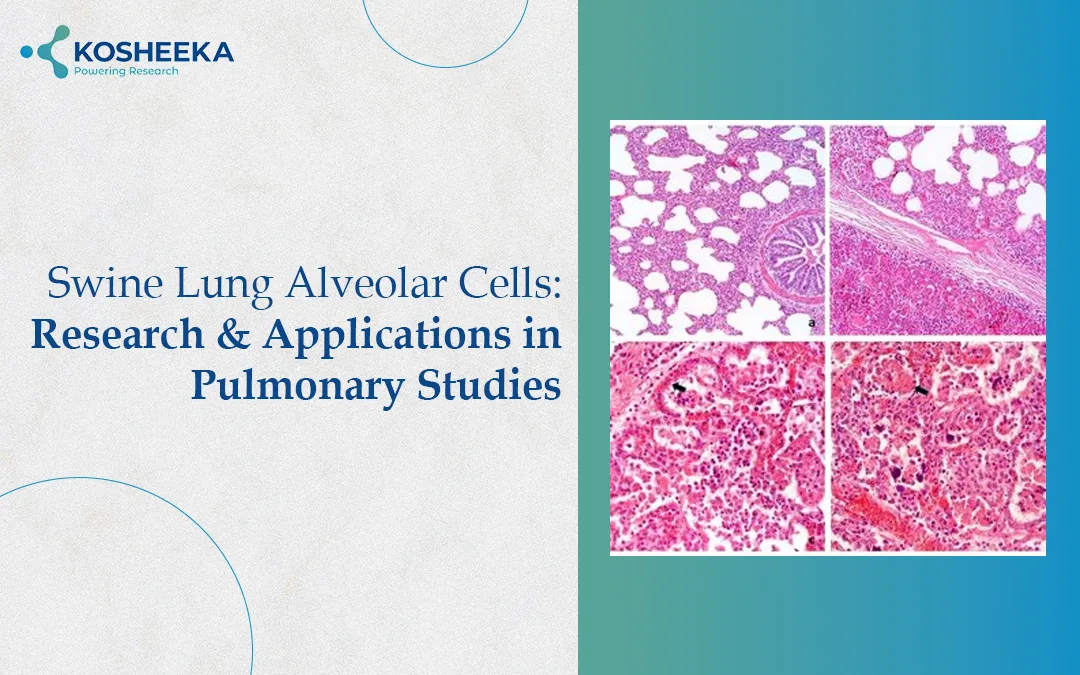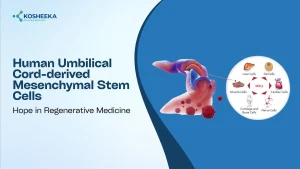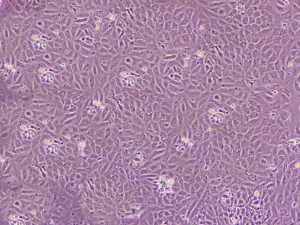Swine Lung Alveolar cells have emerged as a valuable tool in biomedical and veterinary studies, especially in the study of lung physiology and infectious diseases. Owing to their close anatomical and physiological similarity to human lungs, swine lungs serve as an excellent swine respiratory model for translational research, redefining pulmonary science and its applications in the health of animals and humans alike.
Understanding Swine Lung Alveolar Cells
The swine Lung Alveolar region represents the terminal part of the respiratory tree, where gas exchange occurs. This area is composed of alveolar epithelial cells (Type I and II pneumocytes) and resident immune cells like Swine Lung Aveolar Macrophages. Together, they maintain lung homeostasis and act as the first line of defence against airborne pathogens.
Key Cellular Components
- Type I alveolar cells – perform gaseous exchange and alveolar structure.
- Type II alveolar cells – produce surfactant to decrease surface tension and help in alveolar repair.
- Porcine alveolar macrophages – Specialized immune cells, which devour pathogens, clean up, and control immune signaling.
These cells work synergistically to sustain healthy pulmonary function while responding rapidly to microbial invasion.
Alveolar macrophages, interstitial macrophages, and monocytes (differentiated from bone marrow). Scheme of bones in a lung-inflammatory state. Alveolar macrophages are differentiated into the M2 state to phagocytose pollutants and fight inflammation. Source: Choi K. The Role of Macrophages in Airway Disease Focusing on Porcine Reproductive and Respiratory Syndrome Virus and the Treatment with Antioxidant Nanoparticles. Viruses. 2024; 16(10):1563. https://doi.org/10.3390/v16101563 (CCBY 4.0 license)

Why Use the Swine Respiratory Model in Research?
The swine respiratory model closely mimics human lung physiology and immune response, making it more relevant than rodent models in certain contexts.
- Structural similarity: Similar airways bifurcation, alveolar framework and gas-exchange surface area. Accordingly, this resemblance facilitates experienced evaluation of inhaled pathogens, toxic substances, or aerosolized medicine.
- Immunological relevance: Swine immune responses closely resemble those of human cytokine networks.
- Translational potential: Findings from swine studies often apply to human pulmonary diseases such as influenza or ARDS (acute respiratory distress syndrome).
Applications of Swine Lung Alveolar Macrophages in Pulmonary Research
Swine lung alveolar macrophages have become important instrumental research tools in respiratory and immunological studies.
Study of Infectious Diseases:
Swine lung alveolar macrophages have been widely employed to study viral infections, such as those caused by porcine reproductive and respiratory syndrome virus (PRRSV), influenza, and coronavirus. These macrophages assist researchers in understanding how the virus enters, replicates, and evades resistance by the host. The information is thus used in developing vaccines.
Drug Testing and Toxicology:
Swine lung alveolar macrophages mimic the human macrophage responses, making them useful in determining the pulmonary toxicity of nanoparticles or environmental pollutants, or therapeutic aerosols.
Inflammation and Immunomodulation:
The release of some cytokines, such as interleukin (IL)-6, TNF-alpha, and IL-10 by swine lung macrophages regulates inflammation. They are therefore the best to study anti-inflammatory drugs and the mechanisms causing immune dysregulation in chronic respiratory ailments.
Regenerative and Translational Research:
The potential utility of swine lung alveolar stem and progenitor cells to lung tissue engineering and regeneration is currently being studied to replicate diseases and produce tissue patches or bioengineered lungs for use in transplantation.
Techniques for Studying Porcine Alveolar Macrophages
An effective cell isolation and culture of porcine alveolar macrophages determines research success. Common techniques include:
Bronchoalveolar Lavage:
Airway fluid, containing live, viable cells, is collected with the help of sterile saline or PBS added into a lung segment through a bronchoscope or catheter and then aspirated.
Flow Cytometry:
Markers such as CD163, CD14, and CD169, as well as viral proteins or cytokines can be detected to track immune responses, measure phagocytosis using fluorescent particles, and differentiate between M1 and M2 polarization.
RT-PCR and ELISA:
These tools assist in measuring the transcript (mRNA) and protein levels of cytokines (such as TNF-α and IL-10) and chemokines for immune profiling of macrophages, quantifying viral load, and analyzing changes in gene expression during infections or immune stimulation.
Co-culture Systems:
These systems mimic the lung microenvironment and aid in investigating cell interactions during inflammation or infection. For instance, PAMs are also co-cultured with immune cells to investigate macrophage polarization.
Researchers have been able to integrate these approaches and replicate in vivo lung responses with the benefit of advancing research, which involves translation.
Limitations of Swine Lung Alveolar Models
Despite their advantages, these models have some limitations:
- First, ethical and logistical challenges: Rearing and obtaining pigs require specialized facilities and adherence to the animal ethics rules.
- Second, high cost: Swine models are very costly relative to the rodent models, which constrains small-scale studies.
- Third, variability: Both genetic and environmental variance amongst source animals can affect the study’s results.
- Fourth, although gene-editing tools like CRISPR are improving, the methods still have not been as advanced in swine as in mice.
Future Perspectives and Research Opportunities
Omics technologies coupled with advances in tissue-engineering have brought forth a promising future of Swine Lung Alveolar research.
- 3D Lung Organoids from swine alveolar cells to better mimic how lungs work.
- CRISPR-Edited Porcine Models can mimic human genetic disorders, making it possible to study diseases like cystic fibrosis and pulmonary fibrosis.
- Artificial Intelligence (AI) and Data Integration to look at how macrophages respond to drugs and predict how safe they are and how the immune system will react.
- Cross-species Comparative Studies may facilitate advancements in precision medicine within pulmonary care.
Therefore, with these advances, the global respiratory health studies will still rely heavily on the presence of Porcine alveolar macrophages and associated models.
Practical Applications in Veterinary Medicine
Swine Lung Alveolar cells play an important role in the management of respiratory diseases in pigs causing livestock loss. Studies have enhanced PRRSV and swine influenza vaccinations and treatments. This is a crucial aspect of maintaining a healthy balance between humans and animals.
Conclusion
Research on Swine Lung Alveolar cells and Porcine alveolar macrophages has led to new discoveries in pulmonary research, drug discovery, and regenerative medicine. Hence, by combining advanced molecular instruments and powerful respiratory models in swine, scholars are not only enhancing animal health but also hastening respiratory breakthroughs in the treatment of lung diseases in humans.
If you are looking for new ways to study lung diseases or test treatments for respiratory problems, you may want to consider incorporating the swine respiratory model into your work.
FAQ’s
Q- What are Swine Lung Alveolar cells used for?
In both human and veterinary research, they are employed to investigate immune response, infection mechanisms, pulmonary physiology, and drug delivery systems.
Q- Why are Porcine alveolar macrophages important in respiratory studies?
As the lungs’ first line of defense, they aid researchers in their investigation of the interactions between pathogens such as influenza or PRRSV and host cells.
Q- How does the Swine respiratory model compare to human lungs?
The swine lungs have similarities with alveolar structures, immune responses, and exchange of gases; hence, they are a very good substitute in studying human beings.
Q- What are the future prospects of Swine Lung Alveolar research?
The new trends include 3D organoid use, AI-based analysis, and gene-edited pigs that can be better used as simulators of human respiratory conditions.
Q-Are you all set to enhance your pulmonary research?
Collaborate with one of the most successful swine respiratory institutes in the country and look into the future of lung research.



